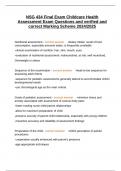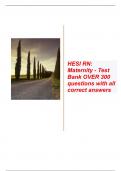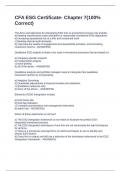NSG 434 Final Exam Childcare Health
Assessment Exam Questions and verified and
correct Marking Scheme 2024/2025
Nutritional assessment - correct answer -dietary intake: recall of food
consumption, especially amounts eaten, is frequently unreliable
-clinical examination of nutrition: hair, skin, mouth, eyes
-evaluation of nutritional assessment: malnourished, at risk, well nourished,
Overweight or obese
Sequence of the examination - correct answer -head-to-toe sequence for
assessing adult clients
-sequence for pediatric assessments generally altered to accommodate child's
developmental needs
-use chronological age as the main criteria
Goals of pediatric assessment - correct answer -minimize stress and
anxiety associated with assessment of various body parts
-foster trusting nurse-child-parent relationships
-allow for maximum preparation of child
-preserve security of parent-child relationship, especially with young children
-maximize accuracy and reliability of assessment findings
Preparation of the child - correct answer -child's perception of painful
procedures
-cooperation usually enhanced with parent's presence
-age-appropriate techniques
,-positioning and preparation
-although the physical examination consists of painless procedures, for some
children the use of a tight arm cuff, probes in the ears and mouth, pressure on
the abdomen, and a cold piece of metal to listen to the chest are stressful.
-for infants and toddlers, perform traumatic procedures last.
-encourage parent/caregiver to assist with holding the child.
-important to get down on a child's level; kids won't trust you unless you do
-don't touch children unless they give you permission (which they do in
various ways)
-never hold a child down or ask a parent to hold them down for a procedure
Physical examination - correct answer growth measurements:
-growth charts
-length
-height
-weight
-skin full thickness and arm circumference
-head circumference
-physical growth parameters include weight, height (length), skinfold
thickness, arm circumference, and head circumference.
-values for these growth parameters are plotted on percentile charts, and the
child's measurements in percentiles are compared with those of the general
population.
-it is important to use the correct measurement tools for the child.
-because growth is a continuous but uneven process, the most reliable
evaluation lies in comparing growth measurements over time because they
reflect change.
,Weight:
-weight is measured with an electronic or appropriately sized balance beam
scale
Head circumference:
-head circumference is a reflection of brain growth.
-measure head circumference in children up to 36 months of age and in any
child whose head size is questionable.
Length:
-until children are 2 years of age and able to stand alone (or 36 months of age
if using a chart for birth to 36 months), measure recumbent length using a
length board and two measurers.
-because of the normally flexed position during infancy, fully extend the body
by (1) holding the head in midline, (2) grasping the knees together gently, and
(3) pushing down on the knees until the legs are fully extended and flat
against the table
Height:
-the term height (or stature) refers to the measurement taken when a child is
standing upright.
-measure height by having the child, with the shoes removed, stand as tall
and straight as possible.
-be certain the child's back is to the wall or other vertical flat surface, with the
head, shoulder blades, buttocks, and heels touching the vertical surface.
-check for and correct slumping of the shoulders, positional lordosis, bending
of the knees, or raising of the heels.
Physiologic measurements - correct answer temperature:
, -electronic intermittent thermometer
-infrared thermometer
-electronic continuous thermometer
-temporal thermometer
Pulse:
-radial
-apical: (heard through a stethoscope held to the chest at the apex of the
heart) is most reliable
-the best place to take a pulse on a child is the apical pulse
-the best place to take a pulse on infants is the brachial pulse
-compare radial and femoral pulses at least once during infancy to detect the
presence of circulatory impairment, such as coarctation of the aorta.
-respiration: count the respiratory rate; in infants, observe abdominal
movements, because respirations are primarily diaphragmatic; if movements
are irregular, count them for 1 full minute for accuracy
Pediatric blood pressure:
-measurement devices
-selection of cuff
-cuff placement
-bp measurement and interpretation
-measured annually in children 3 years of age through adolescence and in
children with symptoms of hypertension, children in emergency departments
and intensive care units, and high-risk infants
-auscultation remains the gold standard method of bp measurement in
children






